Though it’s not a word that is often used to describe him, there is a very sweet portrait of Henry VIII that I would like to discuss today.
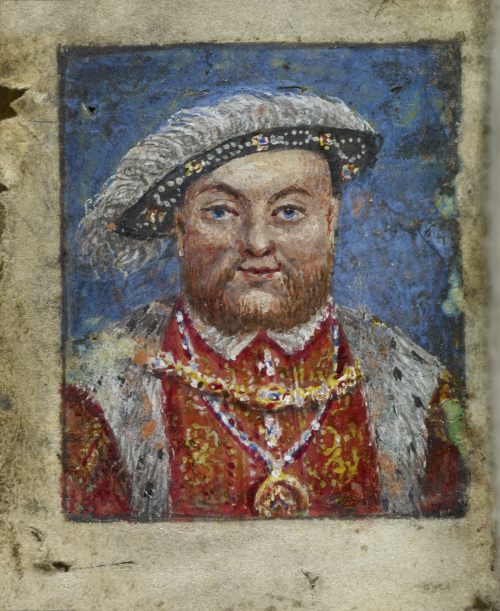
It is a portrait miniature, measuring barely 4x3cm, by an unknown artist. The picture is found in a Tudor girdle book of Psalms. This book is important because tradition has it that this book was owned by Anne Boleyn, an ownership which seems to be borne out by the intimate portrait inside.
Much can and has been written on this exquisite book, though a lot of it is speculative, but I would like to focus on the miniature of Henry.
Anyone’s first impression of the portrait would be how sweet and intimate it is; it seems to show a different side of Henry than is usually portrayed. With the slight smile and warm eyes, it stands out from other portraits from this period. This has led many to conclude that it was made for Anne, or at least someone who shared a very close relationship with the king.
Whilst studying the image, I was struck by the style of the portrait. Despite the different expression, the artist copied the Holbein pattern (it definitely isn’t Holbein’s work, though he may have designed the gold filigree binding), gazing straight out at the viewer, and wearing the signature feathered cap.
This pattern actually poses a problem; the earliest example we have of this pose is 1537, a year after Anne was executed. Holbein was an innovative and uniquely talented artist; it is unlikely that he used someone else’s style. We also have preparatory sketches that Holbein took showing his process in creating this image of the King.
So if the miniature wasn’t painted for Anne Boleyn, what do we know about its creation? Well, research undertaken by Dr. Ellie Jackson, Curator of Illuminated Manuscripts at the British Library where the book is held, notes something interesting about its provenance.
We know that the manuscript is a translation handwritten by John Croke, a clerk of the Chancery during Henry VIII’s reign, due to another manuscript copy of the same book with the same handwriting, which bears a dedication by Croke to his wife, and an inscription by his son which asserts his father’s personal authorship. After that, the book disappears from the records for several centuries. We next hear of it in an account by one Robert Triphook, a London bookseller and publisher. He described the little book in the publisher’s notes of his 1817 edition of George Wyatt’s 16th century biography of Anne Boleyn:
‘This small volume bound in pure gold richly chased 1, 7/8 inch long by 1, 5/8 broad is now in the editor’s possession: its contents are a metrical version of thirteen psalms or parts of psalms, of which the following specimen may not be acceptable…The volume consists of 104 leaves of vellum, on each of which is one verse divided as above into eight lines; a blank of one leaf is between each psalm.’
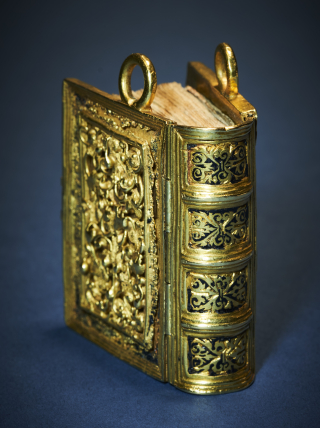
It was similarly described the following year in Triphook’s Bookseller’s Catalogue:
‘MS on Vellum, bound in pure gold, richly chased, 1, 7/8 inch long by 1, 5/8 broad, containing a Portion of Thirteen Psalms, in English Verse, on 104 Leaves of Vellum, 17l, 17s. A description of this celebrated little volume is preserved in Walpole’s…It is said to have been by Queen Anne Boleyn’
What is most noticeable about these descriptions is that they do not mention the miniature portrait of Henry, surely a significant feature, and one which would add value to a catalogue listing.
The manuscript was purchased, presumably for the advertised price of 17l, 17s (approximately £1,025.13 or USD $1,248.35 in today’s money, not a bad price for such a treasure if you ask me) by a man with a very long signature: Richard Temple-Nugent-Brydges-Chandos-Grenville, 2nd Duke of Buckingham and Chandos. He added it to his library at Stowe House – a large part of which was eventually bought by the British Library, now known as the Stowe Collection. Buckingham commissioned a catalogue of his library shortly after acquiring the manuscript, which was completed by 1819:
‘The MS so lettered on the back of the blue morocco case, in which it is contained, is a small prayer book, about two inches and a half in breadth, bound in solid gold, and furnished with two gold rings, through which a gold chain was passed for the purpose of suspending it about the neck of the possessor. The written pages are 196, each about an inch square, and containing an English version of the seven penitential psalms, beginning with a version of the hymn ‘Veni Creator Spiritus.’ The writing is of Henry VIII’s reign, but in a neater and more legible manner than was common in that reign, having been evidently written for a person of high distinction. It is stated to have been by Anne Boleyn on the scaffold, to a lady who attended her, as a mark of remembrance.’
Such a detailed description would surely mention a portrait of Henry VIII, and yet it does not. It isn’t until 1849 that we find the first reference to the portrait. In 1847, the Duke of Buckingham declared bankruptcy, selling off the contents of Stowe House. A catalogue of objects for sale was compiled, presumably including the girdle book, which was purchased by the Earl of Ashburnham, along with many other treasures.
Dr. Jackson’s article states that a reference to the portrait was made around this time, though she doesn’t explicitly state that it was in Stowe House sale catalogue. It may have been in a catalogue of the Earl of Ashburnham. Unfortunately I have not been able to track down the specific reference myself, but Dr. Jackson’s research on the matter is beyond reproach, and her position at the British Library would allow her access to sources that have not been digitised or made readily available.
In 1883, Ashburnham sold the manuscript to the British Museum, and is included in the catalogue of 1895:
‘The Penitential and other Psalms, in English verse [by John Croke, one of the six Clerks in Chancery, and afterwards, 1549- 1564, a Master in Chancery], The volume contains the ” Veni Creator,” the seven Penitential Psalms, and Psalms ix., xiii., xliii., xci., cxxxix…
Vellum; ff. 104. Temp. Henry VIII. At the beginning is a miniature of Henry VIII. A very minute volume, bound in gold. The covers, measuring If inches by If inches, are worked in open leaf tracery, and there are remains of black enamel in the frames round the tracery and the engraved panels of the back. At the top of the covers are two rings, through which a chain was passed to * attach the volume to the girdle. The volume corresponds exactly with one described by the anonymous editor, reported by Mr. Marsham to be Triphook, of George Wyat’s Extracts from the Life of Queen Anne Boleigne p. 29, as being then [1817] in his possession…’
This is the first reference to the portrait that I have been able to find. Assuming Dr. Jackson’s research is correct, the first known reference was in 1849. Considering the other sources which describe the girdle books, which should and would make mention of such a portrait, it seems certain that the portrait miniature was in fact created at some point between 1819 and 1849. At this stage we cannot say who commissioned or created it, though the timing would suggest that it was done on the wishes of the Duke of Buckingham.
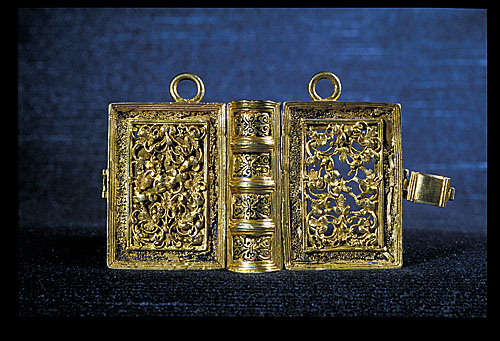
The reason behind the creation of the portrait can be hypothesised, though; Dr. Jackson suggests it was done to lend credence to the story that the book had belonged to Anne Boleyn, perhaps to imply it had been a lover’s gift for Henry himself, lending a romantic air to the piece. In fact, Robert Triphook was the first person to associate this particular girdle book with Anne Boleyn, whether due to misinformation or design is unknown. George Wyatt, writing at the end of the 16th century, does refer to a girdle book which was in the possession of his family, and was believed to have been a scaffold-gift from Anne, but this was a different piece, for which we do have a record and even a sketch; sadly, the current location of it is unknown.
Hopefully we will eventually know the full history of this girdle book – who owned it between its creation by John Croke and its appearance in Robert Triphook’s notes remains a mystery. Though it is disappointing that the charming, intimate portrait of Henry VIII is a 19th century invention, the book is still a remarkable artefact and work of art in its own right. The one thing we can know for sure is that, as the Buckingham catalogue put it, it was ‘evidently written for a person of high distinction.’
You can view the full manuscript for yourself here on the British Library MS Viewer.


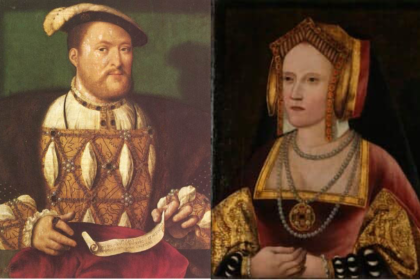
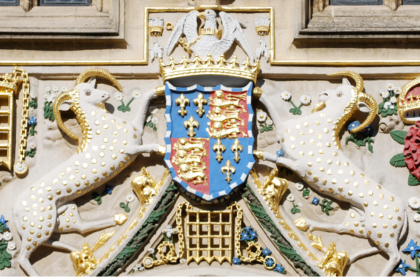

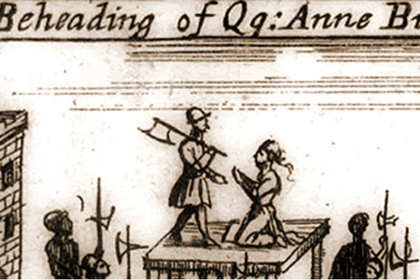
[…] Inventory lists can reveal all sorts of details, such as when a portrait of Henry VIII appeared in a 16th century manuscript (you can read my post on that here). […]